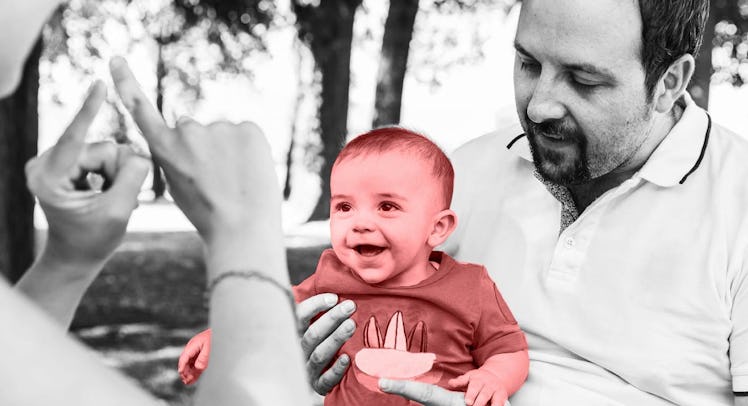How to Teach Your Baby Sign Language So They Can Communicate at 8 Months
Baby sign language gives children as young as 8 months old the vocabulary they need to communicate want and needs with mom and dad.

Long before babies can talk, they learn to communicate with their parents. In the earliest months, that communication is largely a matter of instinct: Discomfort leads to crying, which leads to a parent trying to figure out what the hell is wrong. After four months, baby babble becomes intentional and begins to mimic the inflections of normal speech. Babies will even babble, pause, and wait for parents to reply. By 1 year old, many children are pointing to communicate what they want, but a lack of vocabulary can become frustrating. Thus the appeal of sign language, which can help a kid communicate before they are fully capable of talking.
“All babies are candidates for learning sign language,” explains author and educator Lee Scott, Chair of the Educational Advisory Board for The Goddard School for Early Childhood Development. Scott notes that the best time to start teaching a child sign language comes between the time a baby starts intentionally babbling and the time they start pointing. “We found the best age to start is around six to eight months old when the child has exhibited better hand control. Parents and caregivers can start using the signs anytime even if the child can’t sign back right away.”
How to Teach a Baby Sign Language
- Start introducing signs between six and eight months of age.
- Chose 10 or so signs that relate to the baby’s needs and schedule, like sleep, eat, more, all done, mom and dad.
- Use signs while talking with the baby. But make sure they are part of a language-rich environment.
- Understand that some babies will modify the signs so that they can be done with their limited dexterity. That’s totally fine.
The idea does raise some eyebrows. Babies can communicate through sign? It sounds implausible, but it’s actually true and incredibly helpful. While there isn’t a wealth of studies on the subject, research does indicate that simple modified signs based on American Sign Language can facilitate complex communications — well, moderately complex communications — in advance of words. That means an 8-month-old who may have thrown a frustrated fit can now use the sign for “eat” to help their parents figure out what they need and avoid a scene.
“An additional benefit is that sign language can boost not only language skills such as vocabulary, but also support cognitive development,” Scott says.
Happily, parents do not need to be fluent in sign language for their kid to pick it up. In fact, parent and child can learn together, starting with basic signs that are connected with a child’s immediate needs. Scott suggests the signs for milk, eat, more, mom, dad, all done, sleep, and help. Some kids with siblings might also enjoy learning the signs for “brother” or “sister.”
RELATED: An Army Interrogator On How To Use Body Language To Communicate Better With Toddlers
Just a limited vocabulary of ten signs can be enough to reduce stress in the house. As a kid gets more adept at signing, parents can add signs to their vocabulary that become more specific. A kid who likes apples or bananas might want to know those signs. Signs for colors could be a good way to help children describe their world. But there’s really no need for parents to stress about building a rich sign vocabulary. It is essentially a bridge to verbal communication for typically developing children.
There’s also no need to get the signs perfectly right. “Children who have fine motor issues with hand controls may find it difficult to sign, but often those children adjust and make signs they think resemble the sign you are making,” she explains. “I found these children still benefit from the connection with the adult and even make up their own signs.” And if their made ups signs work? Then so be it. They are doing their job.
In order to teach signs, Scott recommends parents use them as a part of a diverse palate of communication, along with talking, singing, and reading. The idea is to create what she calls a “language rich” environment.
MORE: Babies Develop Logic and Reason Before Language, New Data Shows
Parents can teach a hearing child sign by essentially using the signs in conjunction with the words as the associated object or need is being presented. For instance, when a kid is having dinner, a parent might animatedly say, “Oh you’re eating! Yum!” while making the sign for eating. Or they might ask a child if they want to eat while making the sign for eat and giving them a snack.
There are many resources available for parents who want to learn basic signs. For video tutorials, parents should check out My Smart Hands on YouTube for down-to-earth instruction. There are also websites like BabySignLanguage.com that offer free starter-sign tutorials along with more comprehensive programs for purchase. That said, most libraries will have a baby sign language book and there are baby sign language classes that meet for a nominal fee in most large cities, many of which can be found through SigningSmart.com.
For parents who are going to dive into baby sign language, Scott stresses simplicity and calm. “You want to use signs that fit with your child; keep it simple,” she says. “Relax and have fun with your child. The greatest benefit is the close interaction with your baby.”